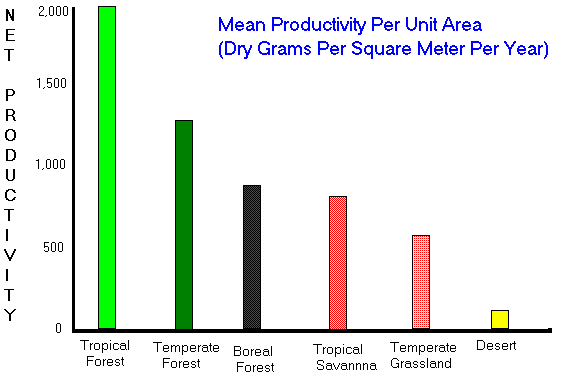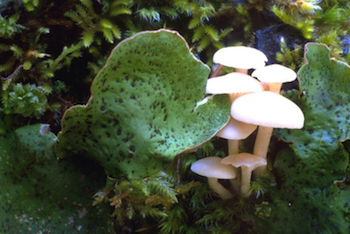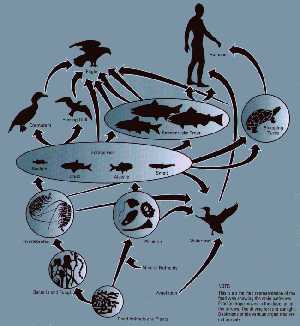12.3: Energy Flow Through Ecosystems
- Page ID
- 16138
Energy capture and use
Photosynthesis
At the base of an ecosystem, primary producers are actively converting solar energy into stored chemical energy. Photosynthesis is the process of converting solar energy, water, and carbon dioxide into carbohydrates and oxygen. The process occurs in two steps: first light energy is absorbed by chlorophyll to split a molecule of water releasing hydrogen and oxygen. The second step uses the energy to convert carbon dioxide to carbohydrates.
Solar Energy
6CO2 + 12H2O --------------> C6H12O6 + 6O2 + 6H2O
(chlorophyll)
The carbohydrate (C6H12O6) can be converted into starch and stored by the plant. Carbohydrate can be combined with other sugar molecules to make cellulose, the basic structural material of a plant.
Video: "Photosynthesis". (Courtesy of Britannica)
Oddly enough, of all the solar radiation striking a plant, only about 1% is used in photosynthesis. The rate of photosynthesis is dependent on several things, especially the amount of light received ... up to a point. As solar radiation increases the rate of photosynthesis increases. For many plants there is an upper limit to the rate of photosynthesis. In some plants as incident solar radiation increases the rate of photosynthesis levels off, or may decrease. The increasing solar energy load causes the plant to be too hot and the need to cool the plant increases. As a result, transpiration takes over as the dominate plant process. Transpiration, the loss of water from plants, acts to cool the plant by releasing latent energy. Adequate supplies of water, carbon dioxide and the availability of nutrients in the soil affect photosynthesis.
Respiration
While photosynthesis builds stored chemical energy in a plant, respiration is the process of "burning" stored chemical energy, basically through oxidation, for maintaining plant metabolism. During plant respiration, carbohydrates combine with oxygen and is reduced to carbon dioxide, water, and heat.
C6H12O6 + 6O2 ---> 6CO2 + 6H2O + 2830 kj
While photosynthesis operates only during day when sunshine is available, respiration goes on both night and day. Plant growth occurs so long as photosynthesis exceeds respiration.
Transpiration
Transpiration is the loss of water from plant leaves. Water exits the leaf through stomata, which are tiny pore spaces in the leaf. The rate of transpiration depends on air temperature and solar radiation. As pointed out earlier, transpiration is a cooing process for plants when temperatures or incident light rise too high and cause heating of the plant. Low humidity, often aided by windy conditions, creates a vapor gradient between the plant and the air. This too induces transpiration. Soil factors are important control over transpiration. If the pore space between soil particles are too large the soil will have poor or low soil capillary. That is, the rate of water rise is too low for plants to extract water from the soil and maintain proper moisture supply. Low soil capillary results from soil drying too. During the moist season, ample soil water is available to line soil particles to aid the movement of soil water upwards to the root zone.
However, during the dry season, a dry layer of soil develops beneath the root zone inhibiting the upward movement of capillary water causing a capillary lag. The plant ultimately wilts as it cannot extract enough water to meet the increasing demand for water during warm seasons. A small soil moisture reserve will inhibit transpiration too.
Biomass Productivity
Net biomass productivity is the difference between gross productivity (production of plant material by photosynthesis) and respiration. So long as the rate of production exceeds that of respiration, the plant will grow. Net productivity represents the amount of organic material produced by a plant. Net productivity is closely related to a number of environmental factors like climate, soils, and available nutrients. Net biomass production will be highest where there is an ample supply of moisture to meet the needs of plants. Biomass productivity is also high where soils are rich in nutrients and have a positive soil moisture balance. The figure below illustrates this well. With ample rainfall and sunlight, the tropical rain forest ranks the highest in terms of organic matter production.

Human pressure on land and vegetation resources for food, wood-based fuel, fiber, and building materials is calling into question whether the earth's net production can sustain such use. Scientists are employing satellite technology to determine the trends in human consumption of net primary production as described in the video below. Human use of earth's annual production rose from 20 to 25 percent from 1995 to 2005. As society looks to land conversion for biofuels, climate changes, and biodiversity loss occurs, a tipping point at which net production fails to meet demand may be reached in the not so distant future.
Video: Human Consumption of NPP. (Courtesy NASA GSFC)
Trophic Levels and Food Chains
The biotic elements that comprise an ecosystem fall into one of several trophic levels. The trophic level of an organism is its position in a food chain, the sequence of consumption and energy transfer through the environment. For example, a simple grazing food chain is comprised of
Plant -> herbivore -> carnivore

At the base of the food chain lies the primary producers. Primary producers are principally green plants and certain bacteria. They convert solar energy into organic energy. Above the primary producers are the consumers who ingest live plants or the prey of others. Decomposers, such as, bacteria, molds, and fungi make use of energy stored in already dead plant and animal tissues. Fungi, like mushrooms, absorb nutrients from the organisms by secreting enzymes to break up the chemical compounds that make up dead plants and animals.

Two laws of physics are important in the study of energy flow through ecosystems. The first law of thermodynamics states that energy cannot be created or destroyed; it can only be changed from one form to another. Energy for the functioning of an ecosystem comes from the Sun. Solar energy is absorbed by plants where in it is converted to stored chemical energy.
The second law of thermodynamics states that whenever energy is transformed, there is a loss energy through the release of heat. This occurs when energy is transferred between trophic levels as illustrated in a food web. When one animal feeds off another, there is a loss of heat (energy) in the process. Additional loss of energy occurs during respiration and movement. Hence, more and more energy is lost as one moves up through trophic levels. This fact lends more credence to the advantages of a vegetarian diet. For example, 1350 kilograms of corn and soybeans is capable of supporting one person if converted to beef. However, 1350 kilograms of soybeans and corn utilized directly without converting to beef will support 22 people!


